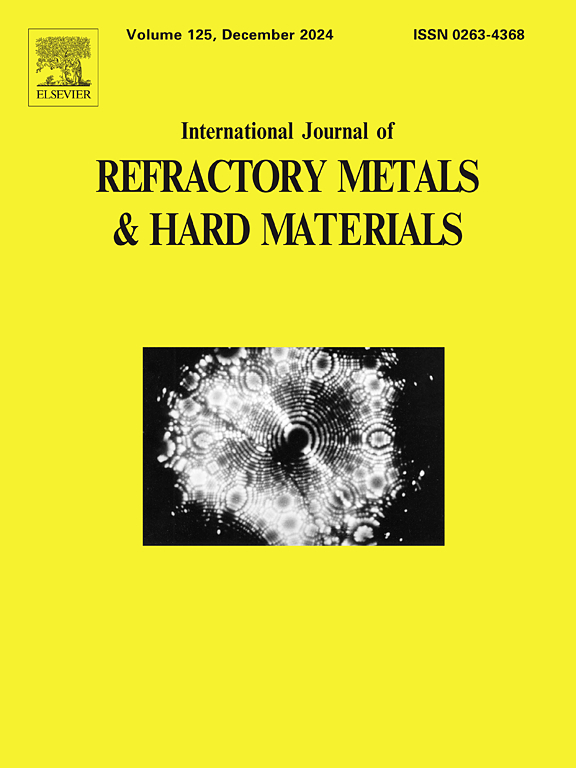Enhanced low-temperature sintering of Mo alloys with Cu-rich binders
IF 4.2
2区 材料科学
Q2 MATERIALS SCIENCE, MULTIDISCIPLINARY
International Journal of Refractory Metals & Hard Materials
Pub Date : 2025-03-24
DOI:10.1016/j.ijrmhm.2025.107161
引用次数: 0
Abstract
Molybdenum (Mo) alloys, known for their exceptional physical and mechanical properties, find applications in aerospace, electronics, and medical fields. However, the high sintering temperatures and long processing times associated with their manufacturing lead to high-temperature furnace requirements and grain coarsening, negatively impacting their cost and mechanical properties. This study investigates the effect of sintering time on the liquid phase sintering (LPS) of Mo alloys containing 10 wt% Cu-rich binders sintered at 1300 °C. Thermodynamic calculations are used to find a suitable Cu-rich ternary binder composition to enhance the wettability of the liquid formed and Mo solubility while preventing the brittle intermetallic compound formation. The densification, microstructural evolution, and phase evolution in the sintered alloys are systematically investigated and correlated. Results revealed that the addition of Fe to the Cu-rich Cu-Ni binder and sintering at 1300 °C for 60 min prevented the formation of brittle intermetallic compounds and significantly improved sintered density (up to 99.2 % of theoretical density) and mechanical properties (Hardness = 342 HV). The sintered density and hardness values achieved in this study are comparable to or better than the reported values of other Mo alloys manufactured at higher sintering temperatures for longer sintering times. These findings demonstrate that the Cu-rich Cu-Ni-Fe ternary binder has a high potential for low-temperature manufacturing of dense, near-net-shaped and intermetallic-free Mo alloys with superior mechanical properties, offering a cost-effective alternative to conventional methods.
富cu粘结剂增强Mo合金低温烧结性能
钼(Mo)合金以其卓越的物理和机械性能而闻名,在航空航天、电子和医疗领域都有应用。然而,高烧结温度和长加工时间导致高温炉要求和晶粒粗化,对其成本和机械性能产生负面影响。本文研究了烧结时间对含10 wt%富cu结合剂Mo合金液相烧结(LPS)的影响。通过热力学计算,找到合适的富cu三元粘结剂组成,以提高所形成液体的润湿性和Mo的溶解度,同时防止脆性金属间化合物的形成。系统地研究了烧结合金的致密化、显微组织演变和相演变过程。结果表明,在富Cu-Ni粘结剂中加入Fe,在1300℃烧结60 min,可防止脆性金属间化合物的形成,并显著提高烧结密度(达到理论密度的99.2%)和力学性能(硬度= 342 HV)。在本研究中获得的烧结密度和硬度值与报道的在较高烧结温度和较长烧结时间下制造的其他Mo合金的值相当或更好。这些发现表明,富Cu-Ni-Fe三元粘结剂在低温制造致密、近网状、无金属间化合物的Mo合金方面具有很高的潜力,具有优异的机械性能,是传统方法的一种经济有效的替代方法。
本文章由计算机程序翻译,如有差异,请以英文原文为准。
求助全文
约1分钟内获得全文
求助全文
来源期刊
CiteScore
7.00
自引率
13.90%
发文量
236
审稿时长
35 days
期刊介绍:
The International Journal of Refractory Metals and Hard Materials (IJRMHM) publishes original research articles concerned with all aspects of refractory metals and hard materials. Refractory metals are defined as metals with melting points higher than 1800 °C. These are tungsten, molybdenum, chromium, tantalum, niobium, hafnium, and rhenium, as well as many compounds and alloys based thereupon. Hard materials that are included in the scope of this journal are defined as materials with hardness values higher than 1000 kg/mm2, primarily intended for applications as manufacturing tools or wear resistant components in mechanical systems. Thus they encompass carbides, nitrides and borides of metals, and related compounds. A special focus of this journal is put on the family of hardmetals, which is also known as cemented tungsten carbide, and cermets which are based on titanium carbide and carbonitrides with or without a metal binder. Ceramics and superhard materials including diamond and cubic boron nitride may also be accepted provided the subject material is presented as hard materials as defined above.

 求助内容:
求助内容: 应助结果提醒方式:
应助结果提醒方式:


